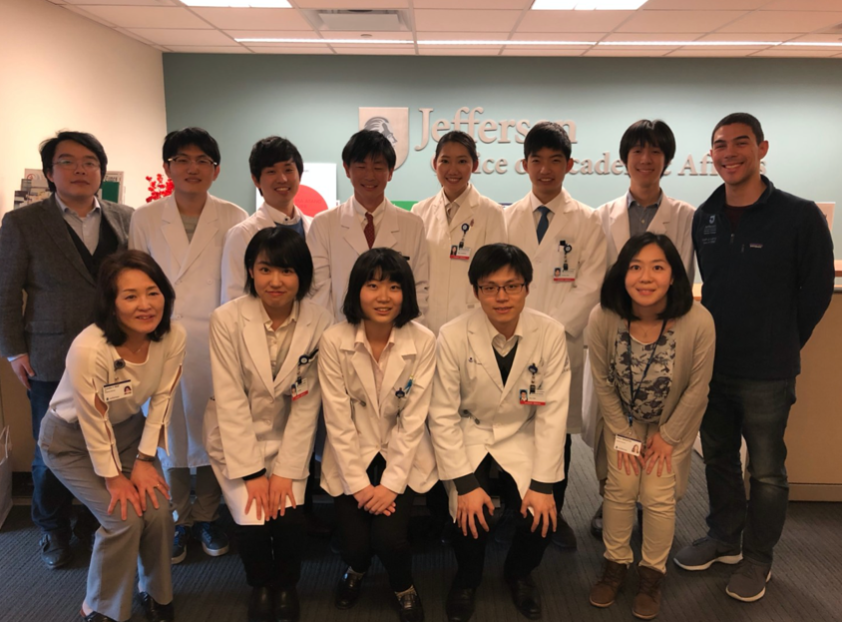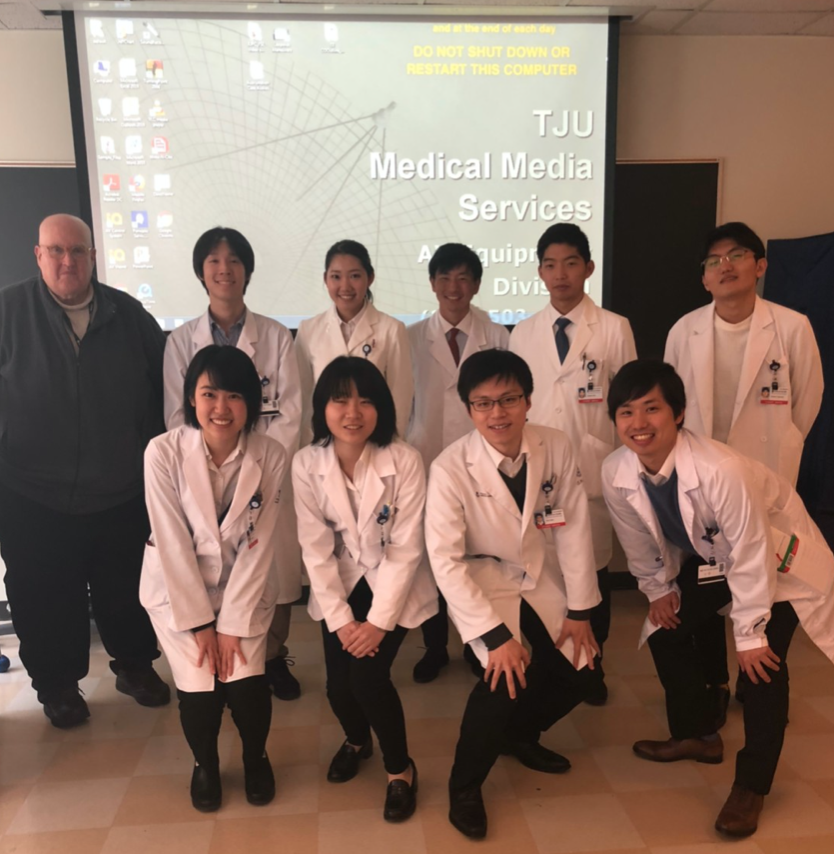Thomas Jefferson UniversityでのClinical Skill Program研修レポート

このプログラムへの参加に際して、私は何か強い意志があった訳ではない。アメリカ合衆国の医療とはどの様なものなのだろうか、という単なる好奇心から応募した。私自身は日本が好きだし将来的にも日本で働きたいと思っている。ただ、留学などの機会があれば積極的な姿勢を示すようにしている。一見すると矛盾する意見に見えるかもしれないが、日本で働くから日本から出ないというのは、私には井の中の蛙と同じように思えてならない。医療に限った話ではないが、現状が良いのか悪いのかはその現状しか知らない人には比較対象がないため評価できない。外の世界を知らずに中の世界を語るのは片手落ちに思える。そのような理由から、私は自分の中での比較対象を増やすために留学に参加した。
今回の研修では外来診療、病棟診療、講義、その他の大きく分けて4つの場面を経験する機会に恵まれた。外来診療はfamily medicine、emergency medicine、pediatricsの3つの科で経験した。外来診療全体を通して、日本よりもプライバシーの配慮に重きが置かれていると感じた。診察室で医師が待っており、そこに患者が呼ばれて入っていくスタイルの日本とは異なり、アメリカ合衆国では診察室に患者が案内され医師よりも先に入っており、そこに後から医師が入っていく形式の外来診療であった。また日本では完全に個室の診察室というのは少なく、半個室のものが多いが、こちらでは完全に個室の診察室であった。このように1か所の診察室に医師が留まらないことで、日本とは違い前の患者情報が残っている状態のところに次の患者が入ってくるという可能性もない。それだけでなく、身体診察時などで患者の準備(泌尿器科診察や産婦人科診察での陰部の露出など)が必要な場合、日本ではカーテンで区切るなどといった程度の配慮となるが、こちらでは医師が一度退室して準備ができたら戻ってくるというより高いレベルでのプライバシー配慮が可能となる。
どう考えても診察室の作りに関しては完全にアメリカ合衆国のものの方が良いように感じられる。日本家屋がそうであるように、診察室に限った話ではなく日本では昔から完全個室という部屋は少ない。しかしながら診察室が半個室なのはそれが理由とは考えにくく、むしろ日本の特殊な医療体制による要因が大きいと思われる。それは全ての国民が健康保険に加入しており、自由に病院受診が可能だというものである。これにより日本の外来は患者で溢れ返り、結果として効率よく多くの患者を捌くという医療者本位の半個室スタイルとなっているのではないだろうか。
病棟診療はinternal medicineのみの見学であった。個人的な感想であるが、外来診療と比べ日本との違いはそこまで多くないと感じた。勿論違いはあり、より多くの時間を病状評価や治療方針のディスカッションにあてている点や、ナースとの情報共有により重きを置いている点などの違いがあった。しかしながらそれらの違い以上に驚いた点がある。それは医学生の存在である。彼らは病棟で一人当たり何人かの患者を担当しており、毎朝のカンファレンスでの病状発表は勿論のこと、治療計画の立案も行っており、また検査のオーダーや薬の処方まで可能(医師の認証が必要であるが)というのは本当に驚いた。日本では基本的に医学生が治療計画や検査オーダー、処方する薬まで考えることはまずない。確かにシステム上できない部分はいくらかあるとは思われるが、日本でも医学生がこれらを考えることは可能である。今後の医学教育ではこのように更に一歩踏み込んだ臨床実習が求められると感じた。
今回の研修で幸運なことに私は自身の希望診療科であるpathologyを見学する機会を得た。アメリカ合衆国の病理は日本の病理と異なる部分も多く沢山の違いを知ることが出来た。まず病理と一言でいっても、そこにはAnatomical Pathology (AP)とClinical Pathology (CP)の2つが含まれる。日本では病理をAPとCPに分けて呼ぶことはなく、また輸血部門は病理には含まれない。APとCPは日本では聞きなれない言葉だが、APの方が一般的にイメージする病理で、外科標本などのスライドを見て診断や評価を下す人が所属している。一方でCPは、細胞診、血液、輸血、細菌などの感染症領域、臨床検査、分子診断学などが含まれており、日本では病理というよりは臨床検査のカバーする領域といえる。基本的にレジデントの時点ではAPもCPも両方とも学び、その後どちらに進むかを決めている。Thomas Jefferson大学病院での病理解剖数は130件/年と日本と比べて倍以上の件数を行っている。
上記の違いはあるものの病理は標本を顕微鏡で見て診断するというプロセスに違いはないため、これ以外は日本とほぼ同じだといえる。では私はアメリカ合衆国の病理に魅力を感じたかというと、正直に言えばこちらで病理医として働きたいとはあまり思わなかった。その理由は以下の通りである。まず、日本では細胞診も外科標本も部署を分けずに病理が担当している。つまり細胞診から外科標本までの一連の流れを自身で追う事が可能であり、情報が増える分よりその標本の理解が進むと思われる。これはこちらでも不可能ではないがやらないのが通常である。また日本で見られない疾患が多く学ぶことが多い、という訳でもない。しかし1点だけ日本に比べて優れている点を挙げると、臓器移植の件数が圧倒的に多いため、移植病理の分野は日本と比べて優れていると思われる。よって、移植病理について学びに来る分にはアメリカ合衆国の病理は素晴らしいと思われるが、そうでなければ日本と比べて魅力的な部分はあまりないと感じた。
謝辞
本研修への参加に際して、国内にいる時から長きにわたりサポートして下さった野口医学研究所のスタッフの皆様、フィラデルフィアにて大変お世話になりましたJapan centerのラディ由美子さん、中村さん、私たちを親身にお世話してくれた医学生のBowenとNoah、Thomas Jefferson大学病院の先生方に心より御礼申し上げます。
Clinical Skill Program at Thomas Jefferson University
Shu Kato (Fujita Health University 6th year medical student)
Most of members had something wonderful ambitions or great reasons when they participated this clinical skill program. Unfortunately, I didn’t have such kind of serious reasons. I just wanted to see and experience the U.S.A. medicine. This was why I applied this program.
I spent meaningful time at Thomas Jefferson University. During my visit, I had four types of experiences; outpatient training, inpatient training, lecture and others.
I went to three departments in outpatient clinics: family medicine, emergency medicine and pediatrics. I felt that privacy was emphasized more than in Japan throughout the outpatient clinic. Unlike in Japan where doctors are waiting in an examining room and patients are called then entered there; in the United States, patients are guided to examining room ahead of doctors, then doctors come later. In Japan, there are not many completely separated rooms, but there are many semi-separated rooms. Unlike the case of Japan, there is no possibility that the next patient will come to the place where the previous patient information remains because the doctor does not stay in one examination room. In addition to that, if it is necessary to prepare the patient (examination of the genital area in urology examination or obstetrics and gynecology examination etc.) at the time of physical examination etc., it will be considered in some degree such as dividing by curtain in Japan. It is possible to consider privacy at a higher level where once you are ready to leave and come back.
It seems like the one in the United States is better for the establishment of the examination room. As is the case with Japanese houses, it is not a story that is limited to the examination rooms, there are few rooms in Japan that are completely private rooms from a long time ago. However, it is hard to think that the reason is the fact that the examination room is a semi-private room, and it seems that the cause of the special medical system in Japan. It is that all the Japanese people have health insurance and can go to the hospital freely. As a result, the outpatients in Japan may be flooded with patients, and as a result, they may become a medical staff-oriented, semi-private room style in which many patients are efficiently consulted.
The inpatient training was a round of internal medicine ward. Although it is personal impression, I felt that there is not much difference with Japan compared with outpatient clinic. Of course, there were differences, and there were differences in that they spent more time to medical condition evaluation and treatment discussions, and that emphasis was put on sharing information with nurses. However, more surprising thing was the presence of medical students. They are in charge of several patients per person in the ward, and they are making medical plans as well as discussing at conferences every morning and are also able to order laboratory tests and prescribe medicines (of course doctor’s confirmation needed). Basically, in Japan, medical students rarely think about treatment plans, examination orders, and prescription of medicines. Certainly, there seems to be some parts that cannot do, but even in Japan it is possible for medical students to think about these. I felt that in the future medical education, clinical training that went one step further would be required.
Acknowledgment
I really appreciate to the staff of Noguchi Medical Research who have supported me for a long time. I am also thanking Ms. Yumiko Radi, Ms. Reiko Nakamura, Bowen and Noah. I really appreciate to the doctors who took care of me at Thomas Jefferson University, especially the kindness from Dr. Chan at pathology department. She kindly accepted me in spite of irregular apply.


